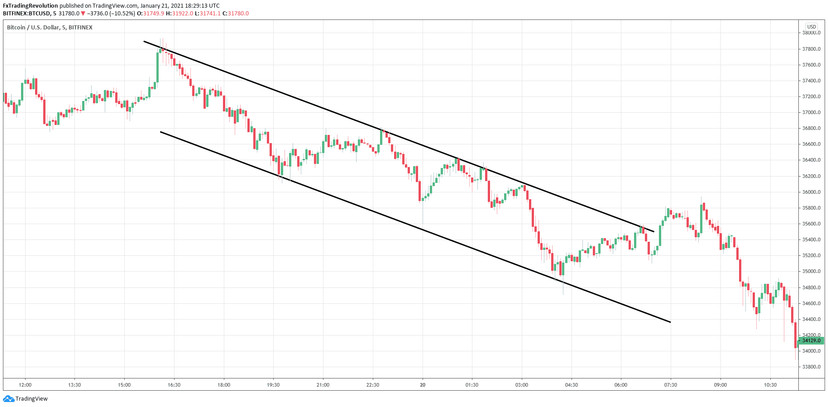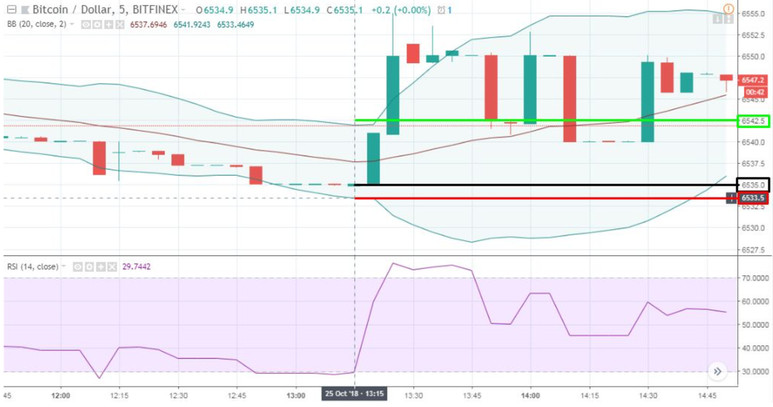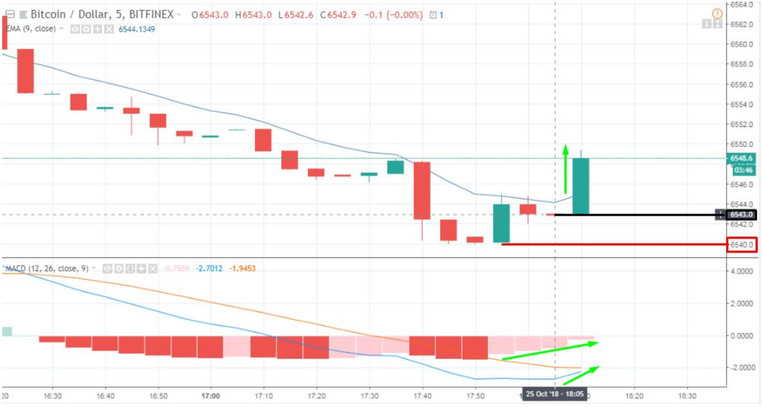There are many ways you can take on the crypto market; you may take long positions with hopes of raising hundreds in weeks or months, or you may take the day trading path.
What’s day trading, you say?
Well, day trading is a trading style where you open short-term trades, most lasting minutes or hours.
The idea is to rack up many moderate trades so that you may close all trades as the day ends to count your gains.
So, now we’re taking an approach to day trading using the 5-minute charts.
1. Starting with Intraday BTC Trading
A lot of beginners when they start with intraday trading Bitcoin or other cryptocurrencies, they do so without stop-loss or take-profit orders. This approach is better used by expert traders since it requires vast knowledge (still they have some mental stop-loss or maximum account drawdown limit), but it’s also used by beginners who don’t understand the importance of the above-mentioned orders.
Since day trading occurs over short periods of time, you can check your trades periodically to see how they’re doing.
This is viable thanks to how the smaller size of the trades allows the opening many more trades (with higher volume in total) than in a long-term investment.
The secret lies in being able to predict the upcoming trends with a high degree of accuracy, usually, with the help of the price action patterns or indicators, that we’ll discuss later.
2. Using Stop-Loss and Take-Profit
These orders aren’t to be placed randomly; you need to use reference points to do so.
A good golden rule is to place them behind the support and/or resistance levels of the current trend. For example:

Here, I see a market trending downwards, so I spot the support and resistance based on the trend channel/falling triangle and place my stop-loss (red) and take-profit (green) right there to protect my SELL order.
Note: While it is a way of doing things, you may use your stop-loss and take-profit as you see fit, and I certainly change my strategies and orders depending on the chart and price action patterns I see forming.
3. The Power Duo: Bollinger Bands and RSI
Bollinger Bands and RSI are one of my favorite combinations for intraday trading (especially M5 trading).

Here, I see a sideways trending market, and it has been oversold (as indicated by the RSI) for a while (the value of the RSI was below the 30 level of the indicator).
As the RSI gives me a BUY signal, I decide to go long (as soon as RSI broke the 30 level). I then use my Bollinger Bands to decide where to place SL and TP orders; I place the SL (red) at the lower band, and round up the TP (green) a bit up.
As you can see the trade met the 6542.5 TP, and the SL was never touched.
4. Coupling Moving Averages: EMA and MACD
Another good combination is the Exponential (EMA) and Convergence/Divergence moving averages (MACD indicator):

Here, I used my regular EMA (with a period of 9) to better spot the trend, just for comfort’s sake. However, the real deal was the MACD.
I spot the momentum bars slowly dying, and the overall bearish trend had been losing momentum (as you can see in the previous bars’ sizes), so I decide to go long after 18:05 when the MACD indicator started moving upside and the market broke above the EMA indicator + the attempt to make another lower low failed and the market broke higher instead.
I placed my stop loss (red) well below the current swing low (support). It is always safe enough to place a SL and TP based on support/resistance price zones, and I also had no reason to think a sudden dip would occur, judging by how the MACD started to move upwards and the last bar was pretty much bullish.
I decided to ride the last green bullish candle and didn’t place a take profit order, preferring to close the position along with the last candle close. As you can see, I exited with a nice and fast profit.
I wouldn't like to give you exact and sure-thing rules that will work all the time.
Instead, I would recommend you to go through the articles here at the Fx Trading Revolution website , see how we trade, read our analysis and educational articles , take advantage of our highly accurate free indicators and get inspired to trade better yourself.
Finally, let me share an important trading principle here: A trader always has to be able to adapt to the current market conditions and the constant changes in these conditions. This is what proved to work for us the best! Stop using fixed rules, and instead turn to adaptive strategies which always tend to work the best over the long-term.
See you here with a new profitable trading strategy in our next post.
Trade well and take care!




